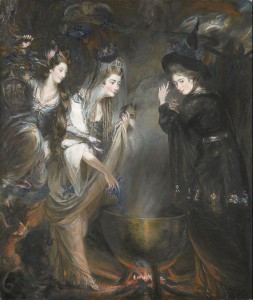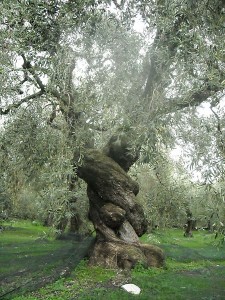At the axis of the worlds there is a tree linking the underworld, the word we live in, and the the ethereal realm of gods and fallen heroes. This is Yggdrasil (IGG-draw-sill), the divine ash tree. The serpent Nidhogg (NEED-hog) nibbles at its roots while an eagle nests in its high branches. The eagle and Nidhogg are sworn enemies, and the squirrel Ratatosk scampers up and down the trunk carrying insults from one to another. Four stags nibble at the lower branches, pruning foliage so Yggdrasil does not grow out of control. At the base of the trunk, on the ground, sit the Norns, the sisters Urd (oord), Verdandi (VAIR-dawn-dee) and Skuld (schooled). They water the roots each day from a pool of white water. Urd is the oldest of the sisters, and some even say the other two are aspects of herself. From her name come the words “earth” and “weird,” which originally meant fate. The Norns set the fate of each child at birth, carving the details in runes on a wooden plank. Those who consult the runes address the Norns before each divination.From Edith Hamilton’s Mythology:
Beside this root was a well of white water, URDA’S WELL, so holy that none might drink of it. The three NORNS guarded it, who “Allot their lives to the sons of men/And assign to them their fate.” The three were URDA (the Past), VERDANDI (the Present), and SKULD (the Future). Here each day the gods came, passing over the quivering rainbow bridge to sit beside the well and pass judgment on the deeds of men.

I hung from a windswept tree,I hung there for nine days and nights,I was gashed, pierced with a spear,I was an offering made to Odin.Offered, myself to myself,On that tree which no man knows,Or where its roots still run.
The wood of the White Ash is very hard, and so it is often used for tool handles, including magical tools. Recall from previous posts that ash is the preferred wood for the witch’s broom handle.The ash is also important in Celtic magic, and it’s tempting to delve into the copious amount of material on this tree. I am limiting myself to the connection between the ash and the Norns, however. If there’s anything you want to share about the ash, even if it’s not related to Germanic lore, feel free to leave a comment.SourcesCooper, D. Jason. Using the Runes.Wellborough, England: The Aquarian Press, 1986.Hamilton, Edith. Mythology. (Reprint) New York: Mentor, 1979.Littleton, C. Scott (ed). Mythology: The Illustrated Anthology of World Myth and Storytelling. London: Duncan Baird Publishers, 2002.

